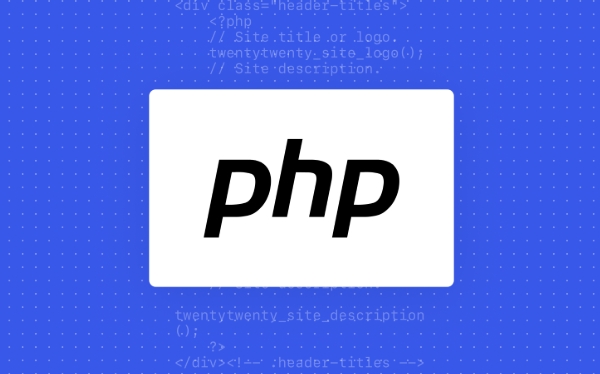 Backend Development
Backend Development
 PHP Tutorial
PHP Tutorial
 Optimizing Conditional Logic: Performance Implications of `if` vs. `switch`
Optimizing Conditional Logic: Performance Implications of `if` vs. `switch`
Optimizing Conditional Logic: Performance Implications of `if` vs. `switch`
Aug 01, 2025 am 07:18 AMSometimes it affects performance, depending on the language, compiler optimization and logical structure; 1. If statements are executed in order, with the worst-case time complexity of O(n), and the most likely condition should be placed first; 2. The switch statement can be optimized by the compiler to a jump table of O(1) when the condition is continuous integer, with many branches and the values are compiled constants; 3. When a single variable is compared with multiple constant integers and there are many branches and the switch is faster; 4. When it involves scope judgment, complex conditions, non-integer types or fewer branches, if it is more suitable or has similar performance; 5. Different languages (such as C/C , Java, JavaScript, C#) have different optimization degrees of switches, and they need to be tested in combination with actual testing; switch should be given priority to use switch to process more than 4 integers or enumeration branches, sort if conditions reasonably, avoid deep nesting, and replace them with lookup tables if necessary. The final performance difference is usually small and should not be optimized too early.

When it comes to choosing between if statements and switch statements in programming, many developers wonder: does it really matter for performance? The short answer is: sometimes — but the impact depends on language, compiler optimizations, and how the logic is structured.

Let's break down the performance implications and best practices for conditional logic using if vs. switch .
1. How if and switch Work Under the Hood
-
ifstatements are evaluated sequentially. Each condition is checked one after another until one evaluates totrue. This means:
- Worst-case time: O(n) for
nconditions. - Best practice: Place the most likely conditions first to minimize average checks.
- Worst-case time: O(n) for
-
switchstatements , on the other hand, can be optimized by compilers into jump tables (also called dispatch tables), especially when:- Cases are continuous or nearly continuous integers.
- There are many cases (typically more than 4–5).
- Values are compile-time constants (eg, enums, integers).
When a jump table is used, execution becomes O(1) — the program can jump directly to the correct block based on the input value.

? Example: A
switchwith cases 1 through 10 might compile to a direct array of function points, whereas the equivalentif-elsechain always checks up to 10 times in the worst case.
2. When switch Can Be Faster
A switch is typically faster than a long if-else chain when:
- ? You're comparing a single variable against multiple constant integral values (int, char, enum).
- ? There are many branches (eg, 5 cases).
- ? The values are dense (like 1, 2, 3, 4, 5 — not 1, 100, 10000).
In these cases, the compiler can generate a jump table , making looksups nearly instantaneous.
switch (value) {
case 1: return "one"; break;
case 2: return "two"; break;
case 3: return "three"; break;
// ...
case 10: return "ten"; break;
default: return "unknown";
} This is much more efficient than 10 sequential if (value == x) checks.
3. When if Might Be Better (or Equivalent)
if statements shine or perform just as well when:
? Cases involve ranges or complex conditions :
if (age < 13) { /* child */ } else if (age < 20) { /* teen */ } else if (age >= 65) { /* senior */ }A
switchcan't handle this cleanly.? Values are strings or non-integral types :
- In older C/C ,
switchonly works with integral types. - In modern languages like Java or JavaScript, string
switchexists but may compile toif-elsechains or hash looksups — no jump table.
- In older C/C ,
? Only a few conditions :
- For 2–3 branches, the overhead of setting up a jump table isn't worth it.
ifis simpler and just as fast.
- For 2–3 branches, the overhead of setting up a jump table isn't worth it.
? Cases are sparse :
-
case 1:,case 1000:,case 2000:— too spread out for efficient jump tables. Compiler may fall back toif-else.
-
4. Language and Compiler Differences Matter
Performance isn't universal — it depends on the language and toolchain:
| Language | switch Optimization | Notes |
|---|---|---|
| C/C | ? Strong support | Jump tables common with dense integers. |
| Java | ? Good for int/enum | JVM can optimize; string switches use hashCode() internally. |
| JavaScript | ?? Limited | switch may be faster for integer-like strings, but engines optimize both. |
| C# | ? Advanced | Supports string switch with internal hashing; often faster than if . |
?? Pro tip: Always profile your code. Compiler optimizations (like LLVM or GCC) can turn well-structured
ifchains into efficient code, sometimes matchingswitch.
5. Best Practices for Optimal Conditional Logic
To write performant and readable conditional code:
- ? Use
switchfor multi-branch integer/enum comparisons with 4 cases. - ? Order
ifconditions by likelihood — most frequent first. - ? Avoid deep nesting; consider lookup tables or dictionaries/maps for complex mappings.
- ? Prefer early returns or
continueto reduce branching depth. - ? Use profile-guided optimization (PGO) in production builds to help compilers make better decisions.
Example: Replace repetitive logic with a map (in languages like Python, JS, Java):
const actions = {
'save': saveDocument,
'open': openDocument,
'print': printDocument
};
actions[command]?.(); This is often faster and cleaner than any if or switch .
Ultimately, the performance gap between if and switch is often negligible in real-world apps unless you're in a tight loop or hot path. But understanding when and why switch can be faster helps you write code that's not just correct — but efficient.
Basically: use switch for many integer/enum cases, if for everything else — and don't optimize prettyly.
The above is the detailed content of Optimizing Conditional Logic: Performance Implications of `if` vs. `switch`. For more information, please follow other related articles on the PHP Chinese website!

Hot AI Tools

Undress AI Tool
Undress images for free

Undresser.AI Undress
AI-powered app for creating realistic nude photos

AI Clothes Remover
Online AI tool for removing clothes from photos.

Clothoff.io
AI clothes remover

Video Face Swap
Swap faces in any video effortlessly with our completely free AI face swap tool!

Hot Article

Hot Tools

Notepad++7.3.1
Easy-to-use and free code editor

SublimeText3 Chinese version
Chinese version, very easy to use

Zend Studio 13.0.1
Powerful PHP integrated development environment

Dreamweaver CS6
Visual web development tools

SublimeText3 Mac version
God-level code editing software (SublimeText3)

Hot Topics
 Demystifying Type Juggling: The Critical Difference Between `==` and `===`
Jul 30, 2025 am 05:42 AM
Demystifying Type Juggling: The Critical Difference Between `==` and `===`
Jul 30, 2025 am 05:42 AM
Using === instead of == is the key to avoid PHP type conversion errors, because == will cause unexpected results, and === compare values and types at the same time to ensure accurate judgment; for example, 0=="false" is true but 0==="false" is false, so when dealing with return values that may be 0, empty strings or false, === should be used to prevent logical errors.
 When Not to Use the Ternary Operator: A Guide to Readability
Jul 30, 2025 am 05:36 AM
When Not to Use the Ternary Operator: A Guide to Readability
Jul 30, 2025 am 05:36 AM
Avoidnestedternariesastheyreducereadability;useif-elsechainsinstead.2.Don’tuseternariesforsideeffectslikefunctioncalls;useif-elseforcontrolflow.3.Skipternarieswithcomplexexpressionsinvolvinglongstringsorlogic;breakthemintovariablesorfunctions.4.Avoid
 The Null Coalescing Operator (??): A Modern Approach to Handling Nulls
Aug 01, 2025 am 07:45 AM
The Null Coalescing Operator (??): A Modern Approach to Handling Nulls
Aug 01, 2025 am 07:45 AM
Thenullcoalescingoperator(??)providesaconcisewaytoassigndefaultvalueswhendealingwithnullorundefined.1.Itreturnstheleftoperandifitisnotnullorundefined;otherwise,itreturnstherightoperand.2.UnlikethelogicalOR(||)operator,??onlytriggersthefallbackfornull
 Beyond `if-else`: Exploring PHP's Alternative Control Structures
Jul 30, 2025 am 02:03 AM
Beyond `if-else`: Exploring PHP's Alternative Control Structures
Jul 30, 2025 am 02:03 AM
The alternative control structure of PHP uses colons and keywords such as endif and endfor instead of curly braces, which can improve the readability of mixed HTML. 1. If-elseif-else starts with a colon and ends with an endif, making the condition block clearer; 2. Foreach is easier to identify in the template loop, and endforeach clearly indicates the end of the loop; 3. For and while are rarely used, they are also supported. This syntax has obvious advantages in view files: reduce syntax errors, enhance readability, and is similar to HTML tag structure. But curly braces should continue to be used in pure PHP files to avoid confusion. Therefore, alternative syntax is recommended in templates that mix PHP and HTML to improve code maintainability.
 Crafting Bulletproof Conditionals with Strict Type Comparisons
Jul 30, 2025 am 04:37 AM
Crafting Bulletproof Conditionals with Strict Type Comparisons
Jul 30, 2025 am 04:37 AM
Alwaysusestrictequality(===and!==)inJavaScripttoavoidunexpectedbehaviorfromtypecoercion.1.Looseequality(==)canleadtocounterintuitiveresultsbecauseitperformstypeconversion,making0==false,""==false,"1"==1,andnull==undefinedalltrue.2
 Refactoring Nested `if` Hell: Strategies for Cleaner Conditional Logic
Jul 30, 2025 am 04:28 AM
Refactoring Nested `if` Hell: Strategies for Cleaner Conditional Logic
Jul 30, 2025 am 04:28 AM
Useguardclausestoreturnearlyandflattenstructure.2.Extractcomplexconditionsintodescriptivefunctionsorvariablesforclarityandreuse.3.Replacemultipleconditioncombinationswithalookuptableorstrategypatterntocentralizelogic.4.Applypolymorphismtoeliminatetyp
 Optimizing Conditional Logic: Performance Implications of `if` vs. `switch`
Aug 01, 2025 am 07:18 AM
Optimizing Conditional Logic: Performance Implications of `if` vs. `switch`
Aug 01, 2025 am 07:18 AM
Sometimes it will affect performance, depending on the language, compiler optimization and logical structure; 1. If statements are executed in order, and the worst case time complexity is O(n), the most likely condition should be placed first; 2. The switch statement can be optimized by the compiler to a jump table of O(1) when the conditions are continuous integers, many branches and the values are compiled constants; 3. When a single variable is compared with multiple constant integers and there are many branches and switches are faster; 4. When it involves scope judgment, complex conditions, non-integer types or fewer branches, if if is more suitable or has similar performance; 5. Different languages (such as C/C, Java, JavaScript, C#) have different optimization degrees of switches, and they need to be tested in combination with actual testing; Swi should be used first
 Leveraging Short-Circuit Evaluation with `&&` and `||` for Performance
Aug 01, 2025 am 07:31 AM
Leveraging Short-Circuit Evaluation with `&&` and `||` for Performance
Aug 01, 2025 am 07:31 AM
Use&&toskipexpensiveoperationsandguardagainstnull/undefinedbyshort-circuitingonfalsyvalues;2.Use||tosetdefaultsefficiently,butbewareittreatsallfalsyvalues(like0)asinvalid,soprefer??fornull/undefinedonly;3.Use&&or||forconciseconditiona






